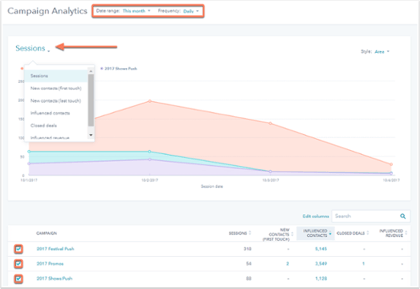Three key metrics to improve your website traffic analysis
Hubspot measures traffic in three basic metrics: page views, visits and sessions. Let's dive into how to define each one. By the end of this blog post, you should be able to distinctly tell the difference between all three of these metrics.
1. Page views - A page view is registered when a page on your site is loaded by a browser.

Technically speaking, a page view happens every time the Hubspot tracking code is loaded. This metric provides insight into the volume and frequency of a user viewing your content. It is the most elementary of the three metrics dicussed in this post.
Use case: A user accesses your site through direct traffic by typing the URL in the browser. After viewing your home page, they click on your products page and then read your blog. They explore the rest of the site, but return to the product page multiple times. At this point, you can begin to gauge their interest in a particular product/service.
Questions to ask: How many pages has this user viewed? Which three pages have the most views?
2. Visits - A visit is registered any time a visitor reaches your site from somewhere outside of your website domain.
This metric provides insight into the volume and frequency of external traffic: organic search, social media and referrals.
Use case: A user found your site through organic search and clicked on a blog post that interested them, but they returned back to the search engine when they finished reading the blog post. Later on in their search, they return to your website when they find another, more relevant blog post. This would be counted as two separate visits. You can begin to gauge what this user is actually interested in.
Questions to ask: When did these visits take place? Did the user leave and then return to the website? If so, what brought them back or kept them interested?
3. Sessions - A session is registered as a measurement of visitor engagement that groups together analytics activities taken by a visitor to your website.
 This metric provides insight into user interest. A session contains any set of actions a user could take on a website such as CTAs, forms and events. Each session expires after 30 minutes so that a new session can be tracked. It's really a way to measure moments where users really dig into your content.
This metric provides insight into user interest. A session contains any set of actions a user could take on a website such as CTAs, forms and events. Each session expires after 30 minutes so that a new session can be tracked. It's really a way to measure moments where users really dig into your content.
Use case: Using the same example as above, say you have a visitor who visited and left the site multiple times in a short 30 minute period. Even though the visitor completely left your site, they have not been inactive for more than thirty minutes, so the second visit to your website is recorded as a continuation of their original engagement to your site. If the visitor chose to return more than thirty minutes after they left your site, their visit would kick off a new session. This shows a deeper level of engagement with the content.
Questions to ask: How many sessions does this user have? How interested does that mean they are in our products or services?
In summary:
Understanding these three basic metrics is the first step to improving your inbound success reporting. By gaining a deep understanding of the page views, visits, and sessions on your website, you can make data-driven decisions to optimize your content and marketing strategies.
With a clear understanding of page views, you can assess the popularity and engagement of your website's pages. By analyzing the number of pages a user has viewed and identifying the top three pages with the most views, you can gain valuable insights into their interests and preferences. This information can guide you in tailoring your content to meet their needs and increase their engagement with your products or services.
Visits, on the other hand, provide insights into external traffic sources and user behavior. By tracking when visits occur and whether users leave and return to your website, you can better understand what attracts them and keeps them interested. This knowledge enables you to optimize your marketing efforts and create more targeted campaigns that resonate with your audience.
Lastly, sessions offer a deeper level of engagement measurement. By grouping together various user actions such as CTAs, forms, and events, you can gauge the level of interest and involvement users have with your content. Monitoring the number of sessions a user has and assessing their interest in your products or services allows you to tailor your offerings and marketing strategies to meet their needs effectively.


